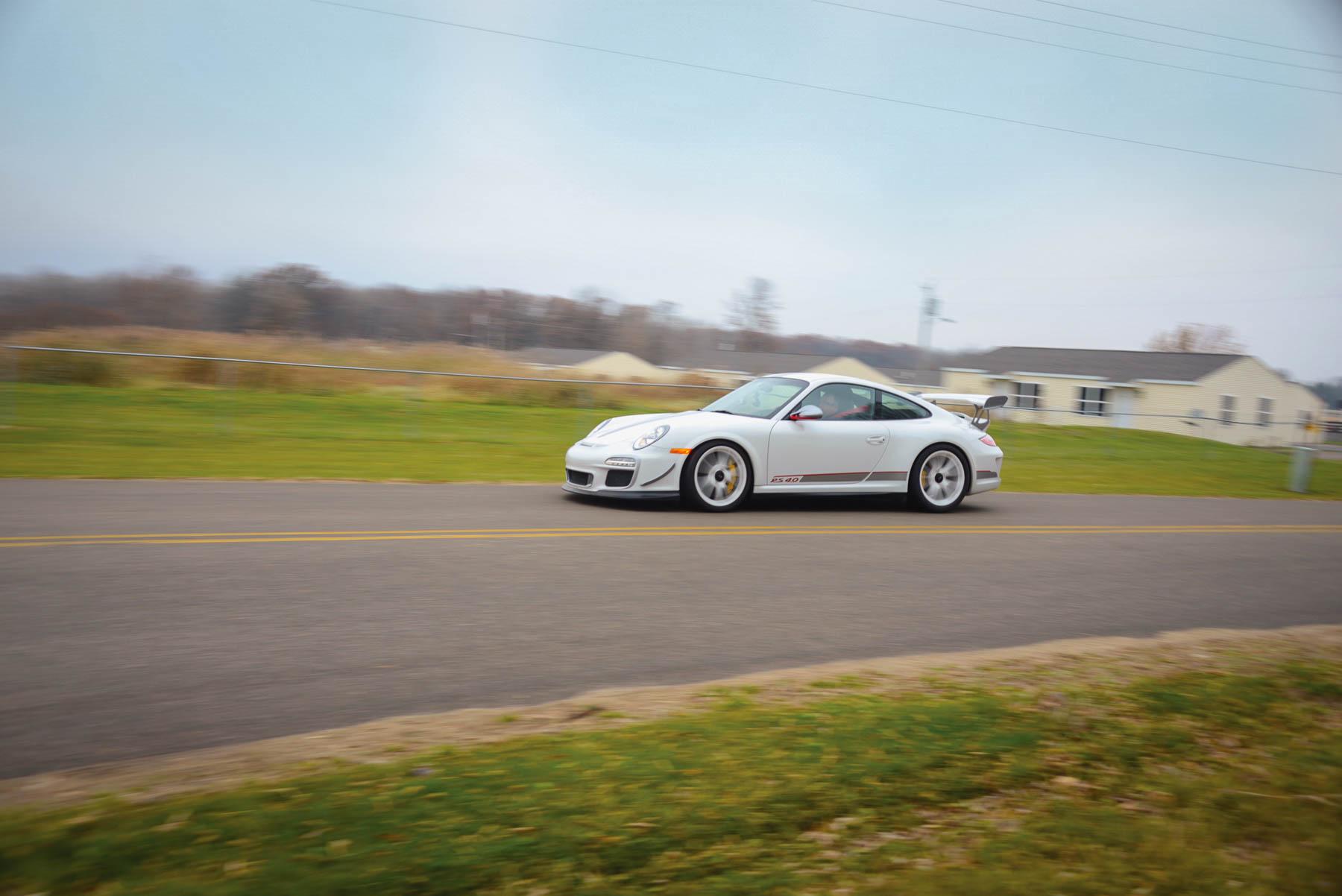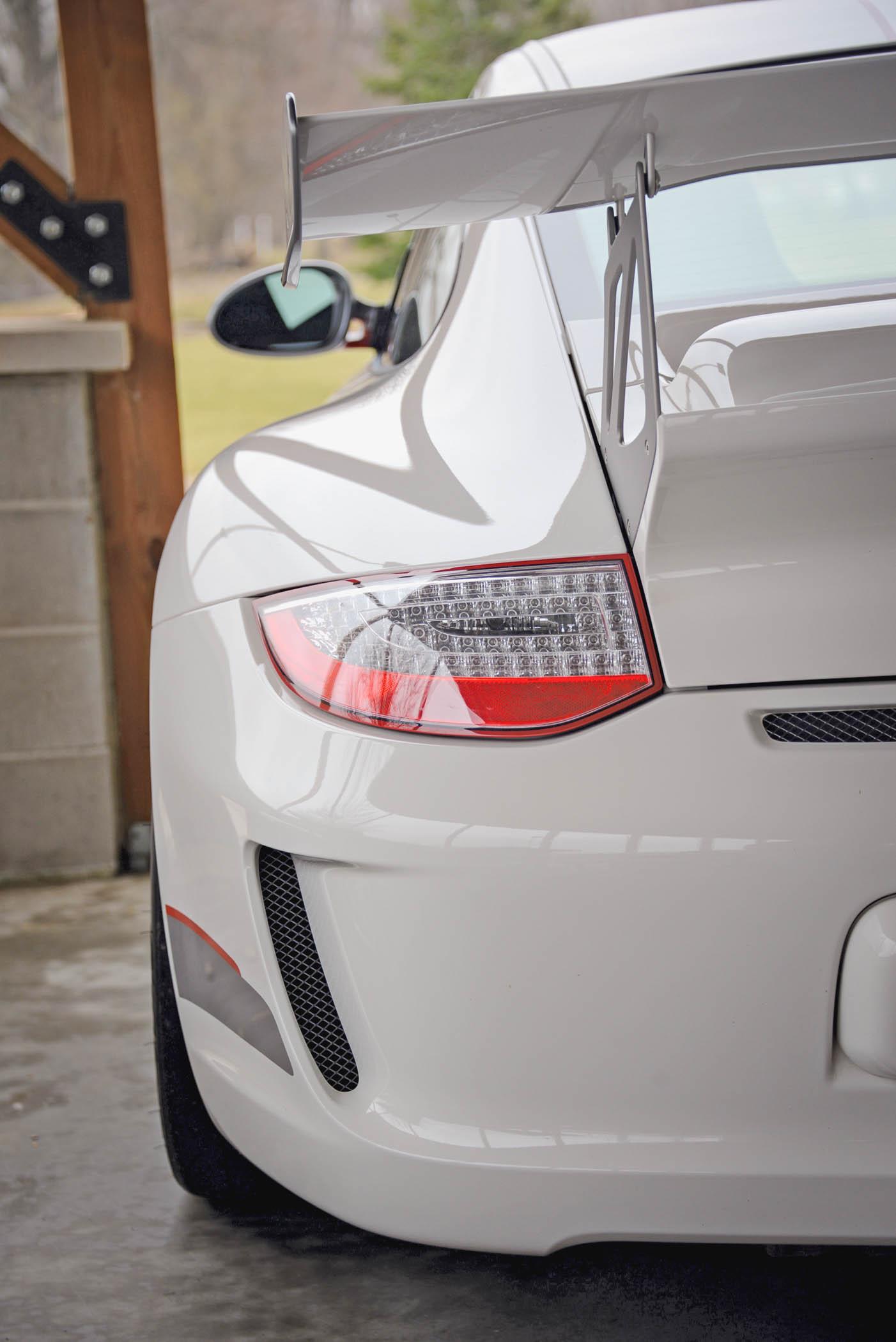
Words and Photos by Jennifer Jensen
I cannot begin to tell you how difficult it has been for me to write this review. How do I share the joys, emotions and feelings that come with driving such a perfect car without sounding like my words were bought and paid for?
There are not enough superlatives to describe Porsche’s 911 GT3 RS 4.0, though I do suppose the name itself is almost long enough all on its own.
So, before I get completely tongue-tied, let’s have a little history lesson.
WHAT’S IN A NAME?
Those two letters and one number — G, T and 3 — have come to exemplify something very special from the wizards at Porsche. Each new iteration of the Porsche 911 GT3 has been more “special” than the one before, while pushing the performance envelope a little further.
GT3 models remove some sound deadening along with all other unnecessary niceties like sunroofs and air conditioning. The engines are tweaked to provide as much naturally aspirated power as possible, and the suspension is upgraded from the standard 911 to be more aggressive for track use.
These efforts have paid off with performance gains above every other 911 save the Turbo.
Then the company decided to put letters after the now famous nomenclature of “GT3,” The first iteration of the venerable GT3, the 996 911 (1999 – 2004), was an astoundingly capable track weapon that could still be used like any other 911. The “RS,” Porsche vernacular for “RennSport” (or Racing Sport in English), was even more hard-core eschewing such niceties as glass for all the windows.
The company put in polycarbonate for the rear window.
A carbon fiber front hood and rear wing paired with carbon-ceramic brakes helped lighten the load, and revised cylinder heads, springs and dampers helped keep the 996 RS hunkered down and pushing just that little bit harder.
Porsche followed a very similar recipe for the 997 GT3 and GT3 RS (2005 –2012). Then they threw the plan book out the window and made this car.
Porsche only made 600 copies of this car!
INSANE ADD-ONS
The 911 GT3 RS 4.0 is the GT3 with all the RS bits and then some insane add-ons. For example, it has a revised rear wing with a new angle of attack (this is adjustable), providing so much downforce that front dive planes (Porsche calls them Flics) had to be added to counterbalance and increase front end grip.
The front trunk lid, front fenders, rear spoiler, sport seats and even the air filter housing are all manufactured in carbon fiber. The doors, brake calipers and spoiler mounts are all made from aluminum, Plus, there are no actual door handles — just a door pull — all in an effort to further reduce weight.
Even the Porsche logo on the front hood is a sticker rather than the actual crest typical of lesser 911’s.
The result is a loss of 22 pounds from the GT3 RS (3.8-liter car), translating to a curb weight of 2,998 pounds. That is pretty amazing considering the engine is bigger, and Porsche added a roll cage.
Unfortunately, the polycarbonate rear quarter windows and rear window were not legalized for the US, meaning the US edition car you see in our photos has actual glass windows, which pushes the curb weight to just more than 3,000 pounds.
THE ENGINE
The absolute, hands-down best thing about this car is the engine. It is the heart and soul of the 4.0-liter, and it is simply astonishing.
It is up only 200 cc’s from the standard GT3 which does not, at first blush, make it seem like there would be that big of a difference. But there is a 50-horsepower gain yielding a max power rating of 500 horsepower at 8,250 rpm. That equates to 125 horsepower per liter!
Maximum torque of 339 pound-feet is reached at 5,750 rpm, but you can feel the well of torque coming on strong from just below 4,000 rpm.
In the GT3 RS 4.0, Porsche used several of the same go-fast bits (crankshaft) from the racing engines that helped their 911 GT1 win LeMans in 1998.
The bore limits of this engine have been reached, so Porsche grew cylinder volume by increasing the stroke (by 4 millimeters) of the forged titanium connecting rods and aluminum pistons by using the crankshaft of the GT3 RSR racecar.
So, this is a racing engine that is still tractable for street use — real every day street use. But 500 horsepower from a 4.0-liter, 6-cylinder!
I stand in awe.
DRIVING
Forget standing, let’s drive.
Twist the ignition, still on the left side of the steering wheel, and the engine barks to life before settling down to a somewhat raucous purr.
The top-dog GT3 features a variable intake manifold with two resonance pipes and switching resonance valves. At low engine speeds both of the resonance valves remain closed. Kick it up a notch, and the first, smaller, resonance valve opens. But as revs continue to rise, the first valve will close, and a second, larger valve will open. Head into the stratosphere with your engine revs, and both valves open up.
Trust me when I tell you that you need to hear this engine with both resonance valves wide open. Porsche’s “sport” exhaust system only helps amplify the spine-tingling aural thrills that this engine can deliver.
Acceleration is fierce with a 0-60 time of under 4 seconds. Porsche claims the deed is done in 3.8 seconds, though sub-3.4 second times have been recorded by other publications.
Suffice it to say that the 4.0-liter is fast.
But cars like this are about so much more than just outright speed and the 4.0-liter delivers on every promise those stripes and wings suggest.
STEERING
The steering is impeccable. It is sharp, direct and more than communicative. Placing the 4.0-liter is second nature after just a few quick turns of the wheel. There is just a hint of mild understeer and then you can feel the bite in the front-end right before the rear end locks down as you push out of a turn.
And if you mess up your line just a little, that is OK too because you can use the power to steer as well.
Revised spring rates on the front McPherson-type struts, metal support bearings with ball joints all around and a rear suspension setup taken directly from the GT2 RS mean the 4.0-liter is all business in the handling department.
Porsche’s DSC (Dynamic Stability Control) has also been re-tuned to provide more freedom and flexibility before the electronics step in.
DRIVE FASTER
Even with all the reworked hardware and those dive planes, on the front, the 4.0-liter is a little light in the nose as the car searches for grip. It didn’t help that the temperature had sunk to well below 50 degrees on our drive, and the roads were greasy with misting rain.
Michelin’s Pilot Sport Cup tires don’t have the tread or temperature values to work properly during road conditions like these, but the 4.0-liter never falters.
Ironically, even in the wet, higher speeds equate more downforce. So, the harder I push, the more the car comes alive. And it is alive. Hearing the singsong nature of the engine as I work the clutch and stick combination while gliding over these roads is the best experience I have ever had behind the wheel.
We have melded, the 4.0-liter and I. The car has become an extension of my limbs, and I do not want the experience to end. Ever!
The chassis is sublimely predictable. If the chassis is upset by road conditions, it immediately comes back under control. There is so much information available from the helm that the 4.0-liter is not scary to push harder and faster.
And it practically begs to be driven faster.
Porsche states that there are 426 pounds of downforce at top speed. I come nowhere close to hitting that limit (193 mph) but the difference is discernable as speed rises. The faster the corner, the better the balance. It all comes so naturally that this car is making me a better driver just by being involved with it.
PLAY TIME
The 4.0-liter also likes to play. It is a master of oversteer, especially when provoked, but even in situations wherein the entire back end of the car is heading down the road sideways you never feel out of control.
It is simply that good.
Tap the brakes, twist the wheel and head on down the road as if nothing was ever out of line. Remember, there are 500 horses at play here, and in the 4.0-liter, you can feel each and every one of them hard at work.
Shifting requires a steady hand as the linkage is quite firm to work through. The clutch is light and easy to modulate, but with the shorter throws of the manual, you need to pay attention so you don’t miss the intended gear.
The GT3 RS 4.0 features a single mass flywheel allowing the engine to rev more freely towards that enticing 8,500 rpm redline. The 4.0-liter also comes standard with dynamic engine mounts. The engine is bolted directly to the body using two active mounts.
The system electronically monitors steering angle and longitudinal and lateral acceleration values. It then adjusts the stiffness of the mounts, using magnetic-reacting fluid in an electrically generated magnetized field similar to the magnetorheological shocks found in many of today’s highest performing sports cars.
All of this technology helps stabilize the car through transitions and changing loads.
In other words: better balance.
THE MOST-FUN CAR
Other automotive manufacturers should take note, and Porsche should remind itself: This car with three pedals, a manual transmission and basic electronic nannies is the most-fun car I’ve ever driven.
Yes, it would probably be faster with Porsche’s fabulous PDK. The new 991 GT3 is faster with four-wheel-steering and even more nannies, but the 997 GT3 involves the driver in ways other modern performance machines simply do not.
The 997 generation Porsche 911 soldiered on for 8 years and the 4.0-liter was Porsche’s last hurrah for both the design and the “Mezger” engine. With this car, the Fat Lady sang a Swan Song with a rousing Huzzah.
It is a wet dream realized.
Originally published in 2014
More from Porsche at https://www.porsche.com/usa/






























